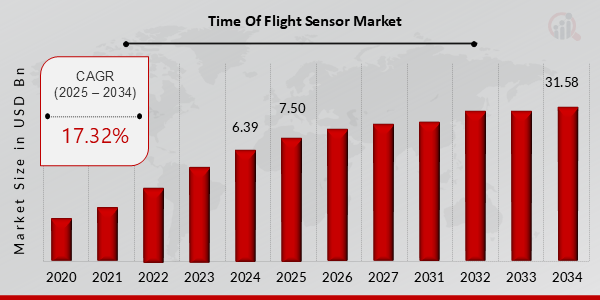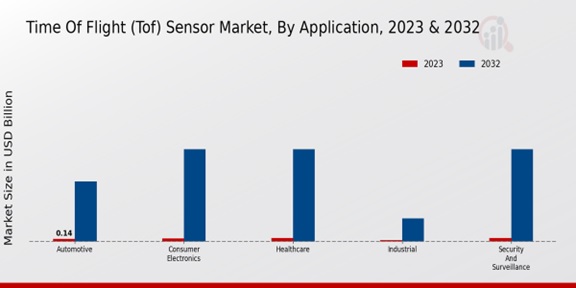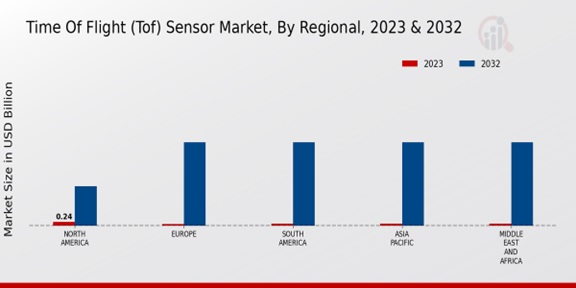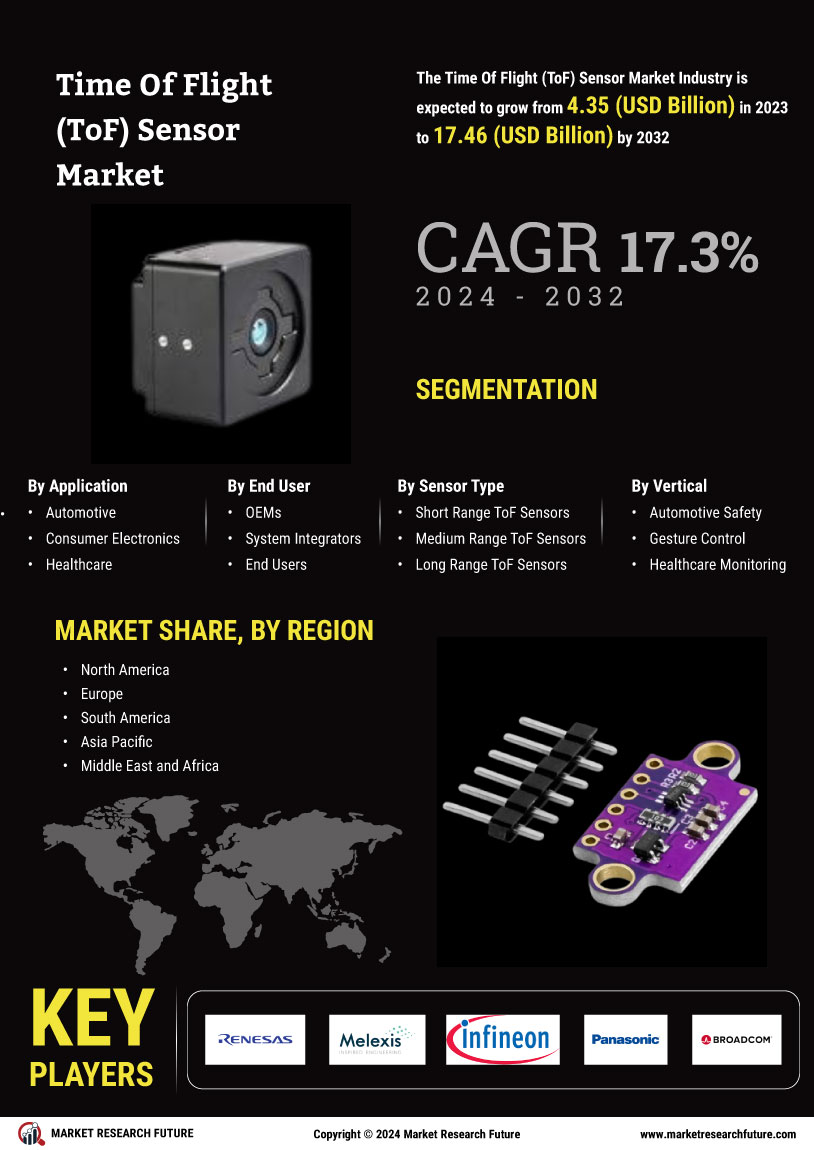Time Of Flight (ToF) Sensor Market Overview
Time Of Flight Sensor Market Size was estimated at 6.39 (USD Billion) in 2024. The Time Of Flight Sensor Market Industry is expected to grow from 7.50 (USD Billion) in 2025 to 31.58 (USD Billion) till 2034, exhibiting a compound annual growth rate (CAGR) of 17.32% during the forecast period (2025 - 2034).
Key Time Of Flight (ToF) Sensor Market Trends Highlighted
Key market drivers for Time of Flight (ToF) sensors include rising demand for advanced driver assistance systems (ADAS), augmented reality (AR) and virtual reality (VR) applications, and increasing adoption in robotics and industrial automation. Opportunities exist in healthcare, security, and surveillance as ToF sensors enable accurate depth mapping and motion tracking.
Recent trends revolve around the miniaturization of ToF sensors, making them more compact and cost-effective for integration into portable devices. Advances in algorithms and software enhance depth accuracy and real-time processing capabilities. The integration of artificial intelligence (AI) and machine learning (ML) algorithms allows ToF sensors to perform object recognition, gesture control, and scene reconstruction.
ToF sensors hold significant potential for emerging applications, such as facial recognition, 3D mapping for autonomous vehicles, and immersive experiences in gaming and entertainment. Their ability to provide precise depth information in real-time makes them crucial for applications requiring accurate spatial understanding and interaction.

Source: Primary Research, Secondary Research, MRFR Database and Analyst Review
Time Of Flight (ToF) Sensor Market Drivers
-
Increasing Adoption of Time-of-Flight Sensors in Automotive Applications
The time of flight sensor is driven by the biggest market in the automotive industry. ToF sensors are advantageous over different and surpassed technology and offer more extra features in terms of precision, accuracy, and reliability. One of the critical elements for its growth within the APAC region, North America has North America as the biggest automotive hub and as the early adopter of technology. The adoption of those three features has grown because of developments in autonomous driving technology, as well as the demand for safety and ease.ADAS, Autonomous driving, and in-vehicle information are the sectors in which the demand has augmented. Global Time Of Flight Sensor Market Industry is projected to grow by 24.3% during the forecast period. In existing times, APAC is the largest vehicle producer; hence, the rising rate of production is the biggest attribute for advancement during the forecast period. Infineon Technologies AG, STMicroelectronics, and Sony Corporation have been contributing the most to these features. Time of Flight sensors are anticipated to gain a substantial position amidst the superior technology and offer more extraordinary benefits than traditional sensors. This technology has gained acceleration as it is more accurate and reliable and provides 13 times better performance than other technologies. In covering the automotive sector, demand for autonomous and ADAS has surged. The Time of Flight Sensor Market Industry is dependent on North America for its expansion; however, during the forecast period, APAC is likely to grow at the highest pace. Influenced by Infineon Technologies AG, STMicroelectronics, and Sony Corporation, the respective industry is expected to grow from USD 0.76 billion in 2023 to USD 5.41 billion by 2032.
-
Growing Demand for 3D Sensing and Imaging Applications
ToF sensors are among the trends that are also taking over in 3D sensing and imaging. ToF sensors can be used to acquire depth data, which is beneficial for 3D sensing and imaging applications, including facial recognition, gesture recognition, and augmented reality. As the number of 3D sensing and imaging applications is growing, the Time of Flight Sensor Market Industry is expected to expand rapidly. As a matter of fact, it is estimated that the Global Time Of Flight Sensor Market Industry will expand from USD 0.76 billion in 2023 to USD 5.41 billion in 2032, at a compound annual growth rate of 24.3% in the period from 2023 to 2032. In conclusion, the time of flight sensor market industry will benefit from the rapidly expanding use of ToF sensors in various consumer electronics devices, including smartphones, tablets, and laptops. The key players in the Time of Flight sensor market industry are, among others, Infineon Technologies AG, STMicroelectronics, and Sony Corporation, which invest large sums in research and development to enhance the performance and decrease the cost of ToF sensors.
-
Advancements in Semiconductor Technology
Darrow, a noted American philosopher, rightly said, “The only things that evolve by themselves in an organization are disorder, friction, and malperformance.” In the years since management has been in use, managers have been concerned with how to make workers more productive. Notably, organizations have been using two different personnel management approaches over the years. The first approach used simple scientific labor-management methods that consisted of rule-of-thumb and reasoning for managing the workforce. The second approach was human management. As a result, it calls for a rational approach to handling the management affairs.
Time Of Flight (ToF) Sensor Market Segment Insights:
Time Of Flight (ToF) Sensor Market Application Insights
Automotive Application’s growing demand for ToF sensors, owing to the increasing popularity of autonomous and semi-autonomous vehicles, is anticipated to drive the Time of Flight ToF sensors market growth. These sensors are an essential part of advanced driver assistance systems (ADAS), and they include lane departure warning, blind-spot monitoring, and adaptive cruise control. In addition, the lower price of ToF sensors compared to other 3D sensing technologies makes them ideal for automotive applications. The automotive end-use segment was valued at USD 0.24 billion in 2023 and is expected to escalate at a CAGR of 26.7% from 2024 to 2032.Growing demand from consumer electronics These sensors are widely used in consumer electronics, such as smartphones, tablets, and gaming consoles, for different applications, such as facial recognition, gesture control, and enhanced AR experience. In addition, the increasing popularity of these products is expected to drive the demand for ToF sensors in this segment. Growing adoption in healthcare ToF sensors is increasing the use of them for medical imaging and surgical applications. It offers numerous benefits, such as high accuracy, real-time imaging, and non-invasive operational methods, making them ideal for use. ToF sensors are being used for intraoperative navigation, robotic surgery, and patient monitoring applications. For industrial applications, These sensors are primarily used to detect objects in proximity, measure distances, and perform gesture recognition. ToF sensors are used in a wide range of industrial applications in different industries, such as manufacturing, logistics, and robotics, to provide enhanced automation, safety, and efficiency in operations. In security and surveillance applications, ToF sensors are being used in facial recognition systems, people counting, measuring cutting pointing detection, dimensioning of objects, and gesture recognition, which are employed in access control and security applications. Many public places, critical infrastructure, and residential areas are opting for enhanced security measures, which use the ToF sensors, thereby driving the segment growth.

Source: Primary Research, Secondary Research, MRFR Database and Analyst Review
Time Of Flight (ToF) Sensor Market End User Insights
End User Overview Global Time Of Flight ToF Sensor Market is categorized into 3 segments – OEMs, System Integrators, and End Users. The End User segment is the largest share-taker in 2023 and is anticipated to claim close to 60% of the total Global Time Of Flight ToF Sensor Market price. The End User segment is made up of the automotive, consumer electronics, healthcare, industrial automation, and other industries. The surge in the End User segment is linked to the rising usage of the Time Of Flight ToF sensors. It is used in gesture recognition, facial recognition, and object detection. There is also a high inclination to use Mylar film capacitors since it offers high voltage. It is also used in smartphones for facial recognition and for augmented reality use. They are also in high demand in the automotive industry for vehicle-to-person and vehicle-to-infrastructure communication, as well as for autonomous driving and parking sensors. With the rise in the application correction for smart homes and for robotics and drones, the End User sub-segment will also gain traction in the Time Of Flight (ToF) Sensor Market.
Time Of Flight (ToF) Sensor Market Sensor Type Insights
The Time Of Flight (ToF) Sensor Market is segmented by Sensor Type into Short Range ToF Sensors, Medium Range ToF Sensors, and Long Range ToF Sensors. Among these segments, the Short Range ToF Sensors segment is expected to hold the largest market share in 2023, owing to its wide range of applications in consumer electronics, industrial automation, and healthcare. The Medium Range ToF Sensors segment is projected to experience significant growth during the forecast period, driven by increasing demand from the automotive and robotics industries. The Long Range ToF Sensors segment is anticipated to witness steady growth, primarily due to its use in applications such as autonomous vehicles and surveillance systems.
Time Of Flight (ToF) Sensor Market Vertical Insights
The Time Of Flight (ToF) Sensor Market is segmented into Automotive Safety, Gesture Control, Healthcare Monitoring, Industrial Automation, and Security and Surveillance based on Vertical. Automotive Safety segment is expected to have the largest market share in 2023, and is projected to continue to grow at a CAGR of 25.6% during the forecast period. Factors driving the growth of this segment include the increasing demand for advanced driver assistance systems (ADAS) and autonomous vehicles, which rely on ToF sensors for object detection, collision avoidance, and lane keeping. Gesture Control segment is also expected to witness significant growth, with a CAGR of 27.1% during the forecast period. The increasing adoption of ToF sensors in consumer electronics devices, such as smartphones, tablets, and gaming consoles, is driving the growth of this segment. The Healthcare Monitoring segment is expected to grow at a CAGR of 23.4% during the forecast period. ToF sensors are used in a variety of healthcare applications, such as patient monitoring, surgical navigation, and rehabilitation. The Industrial Automation segment is expected to grow at a CAGR of 22.8% during the forecast period. ToF sensors are used in a variety of industrial automation applications, such as object detection, robot navigation, and quality control. Security and Surveillance segment is expected to grow at a CAGR of 21.9% during the forecast period. ToF sensors are used in a variety of security and surveillance applications, such as facial recognition, intruder detection, and crowd monitoring. The growth of the Time Of Flight (ToF) Sensor Market is driven by factors such as the increasing demand for ADAS and autonomous vehicles, the rising adoption of ToF sensors in consumer electronics devices, and the growing use of ToF sensors in healthcare, industrial automation, and security and surveillance applications.
Time Of Flight (ToF) Sensor Market Regional Insights
North America led the Time Of Flight (ToF) Sensor Market revenue in 2023, contributing over 36.1% of the market. The region's dominance can be attributed to the presence of key players in the United States, such as Analog Devices, STMicroelectronics, and Texas Instruments. Moreover, the growing adoption of ToF sensors in automotive and industrial applications in the region is further driving market growth. Europe accounted for a significant share of the Time Of Flight (ToF) Sensor Market in 2023, with a revenue share of approximately 29.2%. The region is home to leading automotive manufacturers such as Volkswagen, Daimler, and BMW, who are actively incorporating ToF sensors into their vehicles for advanced driver assistance systems (ADAS) and autonomous driving features. APAC is projected to exhibit the highest growth rate in the Time Of Flight (ToF) Sensor Market during the forecast period. The region's rapid urbanization and industrialization are creating new opportunities for ToF sensors in smart cities, smart homes, and industrial automation. China, in particular, is expected to be a major driver of growth in the APAC region due to government initiatives promoting the adoption of advanced technologies. South America and MEA are expected to contribute a smaller share to the Time Of Flight (ToF) Sensor Market in 2023. However, these regions are witnessing increasing demand for ToF sensors in applications such as mobile devices, consumer electronics, and security systems. As these regions continue to develop economically, the demand for ToF sensors is anticipated to rise.

Source: Primary Research, Secondary Research, MRFR Database and Analyst Review
Time Of Flight (ToF) Sensor Market Key Players And Competitive Insights:
The major global players in the Time of Flight Sensor Market are always working on improving existing products and services with a close eye on market trends and customer demand. The Time of Flight sensor market is being expedited by the need for a higher degree of accuracy, reliability, and efficiency in the operation of diverse domains such as automotive, healthcare, and industrial automation. The leading players in the time of flight sensor market recognized this market demand and hence invested a huge portion of their revenue into R to stay well ahead of the competition. Moreover, the degree of competitive intensity is found to accelerate as a whole, with new players entering the marketplace and leading and strong players expanding their global footprint more aggressively with their Time Of Flight Sensor product offerings.STMicroelectronics is one of the dominant players in the Global Time Of Flight Sensor Market. The company produces a broad range of ToF sensors, which range from sensing a single point to many points, as well as imaging sensors. The devices are used mainly in diverse applications such as smartphones, tablets, wearables, gaming, drones, and automotive systems. STMicroelectronics has been one of the first to innovate and develop ToF technology, and it has been dominant in producing these products to date. STMicroelectronics is a strong player and is expected to remain a major player in the Time of Flight Sensor Market in the upcoming years. Infineon Technologies is another major player in the Global Time Of Flight Sensor Market. The company produces sensors ranging from ToF sensing to a single, multi-point to provide the 2D image of the field of objects. They are used in a wide range of applications, similar to those of STMicroelectronics dates. Infineon Technologies has an extreme focus on R&D and is always vigilant about adding more value to its products from a technological standpoint. Infineon Technologies is expected to remain a major market player in the Global Time of Flight Sensor market in the coming years.
Key Companies in the Time Of Flight (ToF) Sensor Market Include:
- Renesas Electronics Corporation
- Melexis NV
- Infineon Technologies AG
- Panasonic Corporation
- Broadcom Inc.
- Sony Corporation
- ams AG
- STMicroelectronics NV
- Texas Instruments Incorporated
- ON Semiconductor Corporation
Time Of Flight (ToF) Sensor Market Industry Developments
The Time Of Flight (ToF) Sensor Market is projected to reach USD 5.41 billion by 2032, exhibiting a CAGR of 24.3% during the forecast period (2024-2032). The market growth is attributed to the increasing adoption of ToF sensors in various applications, including smartphones, automotive, robotics, and gaming. Recent developments in the ToF sensor market include the launch of new products with enhanced capabilities. For instance, in 2023, Sony introduced its IMX503 ToF sensor with improved depth sensing and low-light performance. Additionally, several companies are investing in research and development to develop ToF sensors with higher resolution and accuracy. The automotive industry is a major driver of the ToF sensor market, as ToF sensors are used in advanced driver assistance systems (ADAS) and autonomous vehicles. ToF sensors provide accurate depth information, which is essential for features such as adaptive cruise control, lane-keeping assist, and automatic emergency braking. Overall, the ToF sensor market is expected to witness significant growth in the coming years, driven by the increasing demand for advanced sensing technologies in various industries.
Time Of Flight (ToF) Sensor Market Segmentation Insights
Time Of Flight (ToF) Sensor Market Application Outlook
- Automotive
- Consumer Electronics
- Healthcare
- Industrial
- Security and Surveillance
Time Of Flight (ToF) Sensor Market End User Outlook
- OEMs
- System Integrators
- End Users
Time Of Flight (ToF) Sensor Market Sensor Type Outlook
- Short Range ToF Sensors
- Medium Range ToF Sensors
- Long Range ToF Sensors
Time Of Flight (ToF) Sensor Market Vertical Outlook
- Automotive Safety
- Gesture Control
- Healthcare Monitoring
- Industrial Automation
- Security and Surveillance
Time Of Flight (ToF) Sensor Market Regional Outlook
- North America
- Europe
- South America
- Asia Pacific
- Middle East and Africa
|
Report Attribute/Metric
|
Details
|
|
Market Size 2024
|
USD 6.39 Billion
|
|
Market Size 2025
|
USD 7.50 Billion
|
|
Market Size 2034
|
USD 31.58 Billion
|
|
Compound Annual Growth Rate (CAGR)
|
17.32% (2025-2034)
|
|
Base Year
|
2024
|
|
Market Forecast Period
|
2025-2034
|
|
Historical Data
|
2020-2023
|
| Market Forecast Units |
USD Billion |
| Key Companies Profiled |
Renesas Electronics Corporation, Melexis NV, Infineon Technologies AG, Panasonic Corporation, Broadcom Inc., Sony Corporation, ams AG, STMicroelectronics NV, Texas Instruments Incorporated, ON Semiconductor Corporation |
| Segments Covered |
Application, End User, Sensor Type, Vertical, Regional |
| Key Market Opportunities |
Industrial automation Automotive applications Healthcare amp medical Consumer electronics Robotics |
| Key Market Dynamics |
Technological Advancement. Rising Demand in the Automotive Industry. Expanding Applications in Mobile Devices4 Growing Awareness of 3D Sensing |
| Countries Covered |
North America, Europe, APAC, South America, MEA |
Frequently Asked Questions (FAQ) :
In 2024, the Time Of Flight (ToF) Sensor Market was valued at approximately USD 6.39 Billion.
The Time Of Flight (ToF) Sensor Market is projected to reach a valuation of around USD 31.58 Billion by the year 2034, exhibiting a CAGR of approximately 17.32% over the forecast period from 2025 to 2034.
The Asia-Pacific region is anticipated to dominate the Time Of Flight (ToF) Sensor Market throughout the forecast period due to the increasing adoption of ToF sensors in various applications such as smartphones, automotive, and industrial automation.
The key growth drivers of the Time Of Flight (ToF) Sensor Market include the growing demand for 3D sensing capabilities in various applications, advancements in ToF sensor technology, and the increasing adoption of ToF sensors in consumer electronics devices.
Some of the prominent players operating in the Time Of Flight (ToF) Sensor Market include STMicroelectronics, Infineon Technologies, ams AG, Sony Semiconductor Solutions, and pmdtechnologies.
Time of Flight (ToF) sensors have a wide range of applications, including gesture recognition, facial recognition, 3D mapping, and object detection. They are commonly used in smartphones, automotive systems, robotics, and industrial automation.
The Time Of Flight (ToF) Sensor Market is segmented based on technology, application, vertical, and region. The technology segment includes pulse-based ToF and continuous-wave ToF. The application segment comprises consumer electronics, automotive, industrial, and healthcare. The vertical segment includes smartphones, tablets, laptops, and gaming consoles.
The Time Of Flight (ToF) Sensor Market faces certain challenges, such as the high cost of ToF sensors, limited range and accuracy in certain environments, and the need for specialized expertise for integration and implementation.
The Time Of Flight (ToF) Sensor Market presents significant growth opportunities due to the increasing demand for 3D sensing capabilities, advancements in ToF sensor technology, and the growing adoption of ToF sensors in emerging applications such as augmented reality and virtual reality.
Key trends shaping the Time Of Flight (ToF) Sensor Market include the miniaturization of ToF sensors, the integration of ToF sensors with other sensors such as cameras and LiDAR, and the development of new applications for ToF sensors in various industries.

















